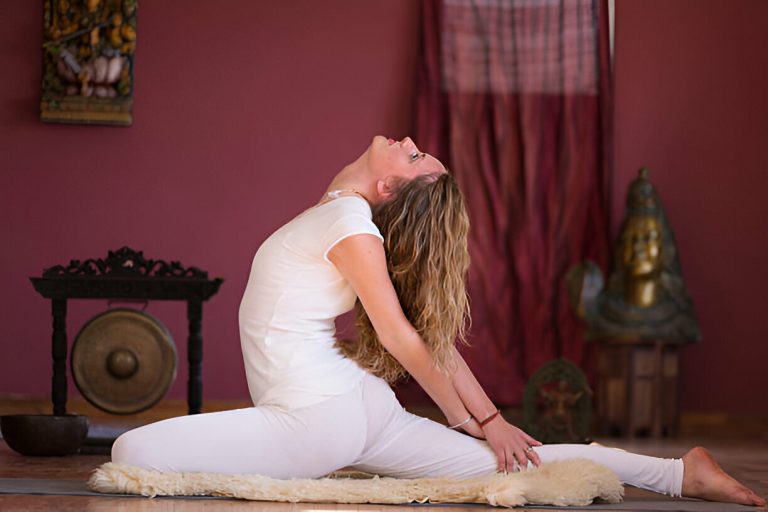Gentle Prenatal Yoga: 5 Safe Poses for a Healthy Pregnancy

Yoga has long been known for its numerous benefits for the mind and body, and this holds especially true during pregnancy. Best yoga poses in pregnancy can help expectant mothers maintain a healthy lifestyle, ease discomfort, and prepare for labor and delivery. With the right poses, pregnant women can experience improved flexibility, reduced stress, and increased strength, all while connecting with their growing baby.
Gentle Prenatal Yoga: 5 Safe Poses for a Healthy Pregnancy focuses on providing expecting mothers with a safe and effective way to practice yoga during pregnancy. These poses are specifically chosen to accommodate the changing needs of a pregnant body, ensuring that both mom and baby remain healthy throughout the journey. From gentle stretches to calming breathing exercises, these poses are designed to support the unique experience of pregnancy.
Next, we will delve into each of the five safe poses included in Gentle Prenatal Yoga, exploring the benefits and modifications for each pose. Expectant mothers can use these poses to ease back pain, improve circulation, and cultivate a sense of calm and relaxation. By incorporating these poses into their daily routine, pregnant women can enjoy a healthier pregnancy and build a stronger connection with their body and baby. Let’s discover how these gentle yoga poses can enhance the journey of pregnancy.
- Practice safe and gentle prenatal yoga poses during pregnancy to help with relaxation, flexibility, and preparation for childbirth.
- Five recommended prenatal yoga poses include the cat-cow stretch, seated side stretch, butterfly pose, supported bridge pose, and child’s pose.
- Always listen to your body and modify poses as needed to accommodate your growing belly and avoid overstretching.
- Focus on deep breathing and mindfulness during each pose to reduce stress, improve circulation, and connect with your baby.
- Consult with your healthcare provider before starting any new exercise routine, including prenatal yoga, to ensure it is safe for you and your baby.
Gentle Prenatal Yoga: 5 Safe Poses for a Healthy Pregnancy
When practicing yoga during pregnancy, safety is of utmost importance. Here are five gentle prenatal yoga poses that are safe and beneficial for both mom and baby:
Downward Dog: A widely recognized yoga pose that helps strengthen the arms, legs, and core while providing a gentle stretch to the back and hamstrings.
Warrior II: This pose is great for opening up the hips and strengthening the legs, helping to improve balance and stability during pregnancy.
Child’s Pose: A restorative pose that helps to relieve tension in the back and hips, while promoting relaxation and stress relief.
Seated Spinal Twist: This pose helps to release tension in the spine and improve digestion, while also stretching the shoulders and chest.
Legs Up the Wall: A relaxing pose that helps to reduce swelling in the legs and feet, while promoting relaxation and easing discomfort.
Benefits of Prenatal Yoga During Pregnancy
Prenatal yoga can offer numerous benefits to expectant mothers, including improved flexibility, reduced stress, and better relaxation. By participating in regular prenatal yoga sessions, pregnant women can also build strength in key areas such as the pelvic floor muscles, which can aid in labor and delivery.
Modifications for Prenatal Yoga Poses
During pregnancy, certain yoga poses may need to be modified to accommodate the growing belly and changes in balance. For example, pregnant women can use blocks or props to help support them in standing poses, or they can practice poses on their hands and knees instead of lying on their back. These modifications ensure that expectant mothers can still benefit from the poses without compromising their safety.
Best Prenatal Yoga Poses for Each Trimester
As pregnancy progresses, certain yoga poses may become more challenging or uncomfortable for expectant mothers. In the first trimester, gentle poses such as Cat-Cow or Child’s Pose can help alleviate early pregnancy symptoms. As the pregnancy advances, poses like Warrior II or Pigeon Pose can help strengthen the body and prepare it for labor. It’s important for pregnant women to listen to their bodies and modify poses as needed throughout each trimester.
Essential Props for Prenatal Yoga Practice
Props such as yoga blocks, straps, and bolsters can be incredibly helpful for expectant mothers during their prenatal yoga practice. These props can provide additional support and stability in poses, making it easier for pregnant women to maintain proper alignment and avoid strain on their joints. Using props also allows pregnant women to stay comfortable and relaxed during their practice, ensuring a safe and beneficial experience.
Importance of Breathing Techniques in Prenatal Yoga
Breathing techniques, or pranayama, are a crucial component of prenatal yoga practice. Deep, mindful breathing can help pregnant women stay calm and focused during their practice, as well as provide relief from any discomfort or tension. Incorporating specific breathing exercises into prenatal yoga sessions can also help expectant mothers connect with their baby and prepare mentally and emotionally for childbirth.
Can I practice prenatal yoga if I have never done yoga before?
Yes, prenatal yoga is suitable for beginners as well as experienced yogis. It focuses on gentle movements and breathing techniques that are safe for pregnant women. It is important to listen to your body and follow the guidance of a qualified prenatal yoga instructor to ensure you are practicing safely and effectively.
Are there any poses I should avoid during prenatal yoga?
Yes, there are certain poses that should be avoided during pregnancy, such as deep twists, backbends, and poses that involve lying on your back for an extended period of time. It is important to work with a prenatal yoga instructor who can modify poses for you based on your individual needs and stage of pregnancy.
How can prenatal yoga benefit both me and my baby?
Prenatal yoga can provide a variety of benefits for both you and your baby. It can help improve circulation, reduce stress and anxiety, increase strength and flexibility, and promote relaxation and mindfulness. Additionally, practicing prenatal yoga can help prepare your body for childbirth and aid in postpartum recovery.
Is it safe to practice prenatal yoga in the first trimester?
Yes, it is generally safe to practice prenatal yoga in the first trimester of pregnancy. However, it is important to listen to your body and avoid any poses or movements that feel uncomfortable or painful. It is recommended to inform your prenatal yoga instructor of your pregnancy so they can provide modifications as needed.
Can prenatal yoga help with common pregnancy discomforts?
Yes, prenatal yoga can be beneficial for alleviating common pregnancy discomforts such as back pain, pelvic pain, and sciatica. The gentle movements and stretching in prenatal yoga can help improve circulation, reduce muscle tension, and increase flexibility, providing relief from these discomforts.
How often should I practice prenatal yoga?
It is generally recommended to practice prenatal yoga 2-3 times per week to experience the full benefits. However, it is important to listen to your body and adjust your practice as needed based on how you are feeling. If you are new to yoga, you may start with less frequent sessions and gradually increase as you become more comfortable.
Can prenatal yoga help prepare me for labor and childbirth?
Yes, prenatal yoga can help prepare you for labor and childbirth by improving strength, flexibility, and endurance. The breathing techniques and mindfulness practices taught in prenatal yoga can also be beneficial for managing pain and staying present during labor. It is important to discuss your birth plan and any specific concerns with your prenatal yoga instructor so they can tailor your practice accordingly.
Is it safe to practice prenatal yoga if I have a high-risk pregnancy?
If you have a high-risk pregnancy, it is crucial to consult with your healthcare provider before starting any new exercise routine, including prenatal yoga. Your healthcare provider can provide guidance on what types of exercise are safe for you and your baby. If given the green light, you may still be able to practice prenatal yoga with modifications, but it is important to prioritize your health and safety throughout your pregnancy.
What should I look for in a prenatal yoga instructor?
When choosing a prenatal yoga instructor, it is important to look for someone who is certified in prenatal yoga and has experience working with pregnant women. You should feel comfortable and supported in their classes, and they should be knowledgeable about prenatal modifications and safety guidelines. It can also be helpful to ask for recommendations from other pregnant women or healthcare providers to find a qualified instructor.
Can I continue practicing prenatal yoga after giving birth?
Yes, you can continue practicing prenatal yoga after giving birth as a form of postpartum exercise and self-care. Prenatal yoga instructors often offer postnatal classes specifically designed for the postpartum period, focusing on rebuilding strength, restoring flexibility, and supporting overall well-being. It is important to listen to your body and make any necessary modifications as you navigate the postpartum recovery process.
Final Thoughts
The best yoga poses in pregnancy can provide numerous benefits for both the mother and her growing baby. It is important to prioritize safety and listen to your body throughout your prenatal yoga practice. Five safe poses that are highly recommended for a healthy pregnancy include Cat-Cow stretch, Child’s pose, Butterfly pose, Modified pigeon pose, and Legs up the wall pose. These poses can help improve flexibility, reduce stress, alleviate common pregnancy discomforts, and promote overall well-being.
By practicing gentle prenatal yoga regularly, expectant mothers can strengthen their bodies, calm their minds, and prepare for the physical demands of childbirth. It is essential to consult with a healthcare provider before starting any new exercise routine, including prenatal yoga, to ensure that it is safe for both the mother and the baby. Remember to modify poses as needed, avoid overstretching, and always listen to your body’s cues.
Incorporating the best yoga poses in pregnancy into your daily routine can have a positive impact on your pregnancy journey. Stay consistent, stay mindful, and embrace the physical and emotional benefits that prenatal yoga has to offer. Embrace this time of connection with your body and your baby, and enjoy the journey towards a healthy and happy pregnancy.






